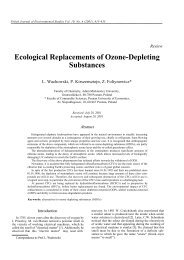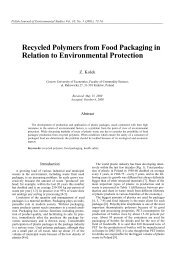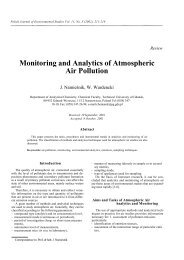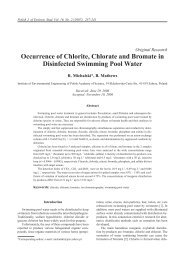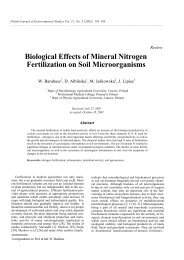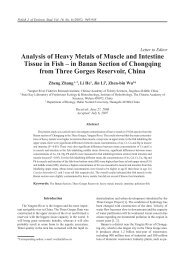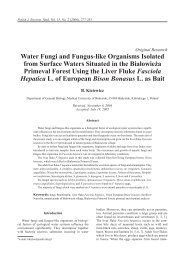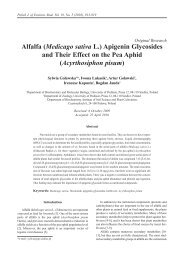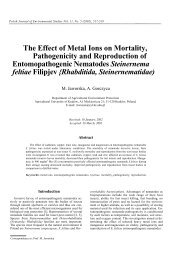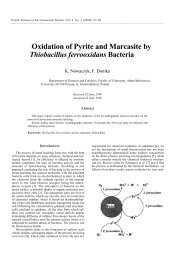Evaluation of Chelating Agents as Heavy Metals Extractants in ...
Evaluation of Chelating Agents as Heavy Metals Extractants in ...
Evaluation of Chelating Agents as Heavy Metals Extractants in ...
Create successful ePaper yourself
Turn your PDF publications into a flip-book with our unique Google optimized e-Paper software.
152 Kociałkowski W.Z. et al.<br />
<strong>Chelat<strong>in</strong>g</strong> agents are <strong>in</strong>volved <strong>in</strong> metal complexation by<br />
provid<strong>in</strong>g N (nitrogen) and O (oxygen) atoms <strong>as</strong> donors.<br />
The number <strong>of</strong> these atoms may determ<strong>in</strong>e the chelat<strong>in</strong>g<br />
strength, (HEDTA: 2 N and 4 O - stronger chelation and<br />
NTA: 1 N and 3 O - weaker chelation). The results suggest<br />
that, <strong>in</strong> most <strong>in</strong>vestigated soils, the chelation <strong>of</strong> Cu w<strong>as</strong><br />
sufficient to remove all that could be rele<strong>as</strong>ed simply by<br />
decre<strong>as</strong><strong>in</strong>g the activity <strong>of</strong> Cu 2+ . A similar c<strong>as</strong>e w<strong>as</strong> reported<br />
by Norvell [15], who stated that <strong>in</strong> some Cu-contam<strong>in</strong>ated<br />
soils, the rele<strong>as</strong>e <strong>of</strong> Cu appeared to be related to differences<br />
<strong>in</strong> the stability <strong>of</strong> the Cu chelate formed. This discrepancy<br />
may be a pro<strong>of</strong> <strong>of</strong> different forms <strong>of</strong> soil Cu <strong>in</strong> metal-free<br />
and/or metal-contam<strong>in</strong>ated soils. Copper is reported to present<br />
a high aff<strong>in</strong>ity towards soil organic substances conta<strong>in</strong><strong>in</strong>g<br />
N and O <strong>as</strong> donors [8, 16]. Then <strong>in</strong> organic matter<br />
relatively rich soils the use <strong>of</strong> ammonium acetate for <strong>as</strong>sess<strong>in</strong>g<br />
even exchangeable forms <strong>of</strong> Cu may lead to an underestimation<br />
<strong>of</strong> the amounts <strong>of</strong> Cu be<strong>in</strong>g extracted. Correlations<br />
among the amounts <strong>of</strong> extracted Cu for chelat<strong>in</strong>g<br />
agents were excellent, (r > 0.96, P < 0.05). Only EGTA<br />
showed a high relationship with NH 4 OAc (R 2 = 0.94), <strong>as</strong><br />
illustrated <strong>in</strong> Fig. 6. None <strong>of</strong> the extractants strongly correlated<br />
with soil physicochemical properties (except for<br />
HEDTA), but the value <strong>of</strong> the coefficient <strong>of</strong> determ<strong>in</strong>ation<br />
w<strong>as</strong> low:<br />
Cu-HEDTA = 66.3 - 14.0 pH - 4.2 CEC + 5.8 Corg -<br />
- 0.11 Clay, R 2 = 0.23 (P < 0.05) (2)<br />
Extraction <strong>of</strong> Zn<br />
Extractable Zn <strong>of</strong> the 16 soils varied slightly (about<br />
15.0 mg Zn/kg) between chelat<strong>in</strong>g agents. Notably less Zn<br />
w<strong>as</strong> extracted by NH 4 OAc <strong>in</strong>dicat<strong>in</strong>g its relative <strong>in</strong>effectiveness<br />
(Table 3). HEDTA, EDTA, NTA, and EGTA extracted<br />
on average 33% <strong>of</strong> total Zn, where<strong>as</strong> NH 4 OAc alone<br />
extracted 14% (Figures 1, 2, 3, 4, 5). Apparently, each <strong>of</strong><br />
these chelat<strong>in</strong>g agents chelated Zn well enough to extract<br />
all the Zn that could be <strong>in</strong> soil solution or <strong>in</strong> exchangeable<br />
forms. Some reports have focussed on the moderate ability<br />
<strong>of</strong> Zn to be bound strongly <strong>in</strong> soil lead<strong>in</strong>g to a possible high<br />
Zn extractability [3, 14]. Furthermore, it is worth not<strong>in</strong>g that<br />
Zn levels <strong>in</strong> the soil samples are not high, so weakly-bound<br />
forms will be <strong>in</strong>sufficient. This could be more or less<br />
expected s<strong>in</strong>ce the amounts <strong>of</strong> Zn extracted by NH 4 OAC<br />
rema<strong>in</strong>ed very low. Among all extractants (<strong>in</strong>clud<strong>in</strong>g the<br />
chelate-free one) only the amounts <strong>of</strong> Zn extracted by<br />
NTA showed the highest correlations with all soil<br />
physicochemical properties:<br />
Zn-NTA = 16.4 - 3.1 pH + 0.7 CEC - 0.1 Corg + 0.03 Clay,<br />
R 2 = 0.71 (PNH 4 OAc (14%) (4)



